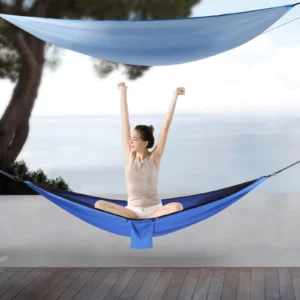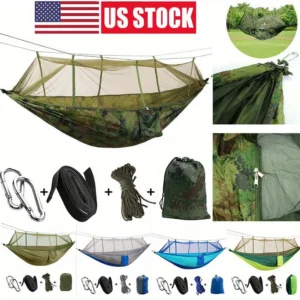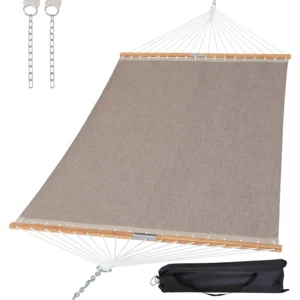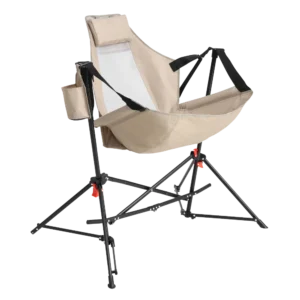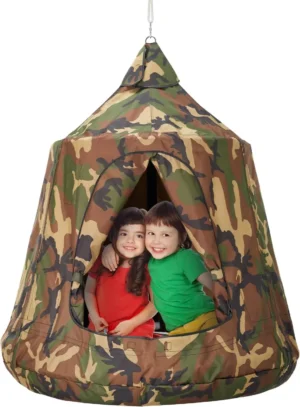What Defines an “Ultralight” Hammock for Camping?
In the world of outdoor gear, “ultralight” has become more than just a marketing term—it represents a specific category of equipment designed to minimize weight without sacrificing essential functionality. For hammocks specifically, the ultralight designation typically applies to those weighing under 16 ounces (450g), which is significantly lighter than their standard counterparts that can weigh anywhere from 16-32 ounces (450-907g).
This weight reduction isn’t merely about numbers—it reflects a broader philosophy in the outdoor community that values efficiency and mobility. Ultralight hammocks represent a strategic approach to reducing pack weight while still maintaining a comfortable sleeping system, often packing down to the size of a grapefruit compared to the larger packed dimensions of standard options.
Ultralight Hammock Definition
A camping hammock weighing less than 16 ounces (450g), typically constructed from high-performance technical fabrics, featuring minimalist design principles while maintaining adequate comfort and structural integrity for overnight use.
The evolution of these lightweight suspension systems marks a significant advancement from the heavier cotton and rope designs of traditional hammocks. Today’s ultralight camping hammock sets represent the cutting edge of material science and design efficiency, offering campers a compelling alternative to ground-based sleeping systems while reducing pack weight by pounds, not just ounces.
Premium Materials: The Science Behind Ultralight Strength
The remarkable weight reduction achieved by ultralight hammocks isn’t magic—it’s materials science. The fabrics used in these systems represent the perfect intersection of strength, weight, and durability, often utilizing the same advanced textiles found in high-performance sailing and aerospace applications.
Denier ratings (a measurement of fiber thickness) play a crucial role in determining both the weight and strength of hammock fabrics. While standard camping hammocks might use 70D (denier) nylon, ultralight models often feature:
- Ripstop Nylon (15D-40D): Interwoven with stronger reinforcement threads in a grid pattern to prevent tears from spreading
- High-Tenacity Polyester: Offers superior UV resistance and maintains dimensional stability when wet
- Dyneema® Composite Fabrics: Incredibly strong fiber with one of the highest strength-to-weight ratios of any material on earth
- Monofilament Construction: Single-strand fibers that reduce weight while maintaining strength
The weight difference between materials is substantial—a hammock made from 70D nylon might weigh 20 ounces (567g), while a comparable 20D ripstop version could weigh just 10 ounces (283g). Premium manufacturers enhance these materials with specialized construction techniques like triple-stitched seams and strategic reinforcement at stress points.
Of course, these advances come with trade-offs. The thinner the material, the more careful users must be about sharp objects, abrasive surfaces, and UV exposure. Many lightweight hammock sets balance these concerns by using slightly more durable fabrics at critical connection points while keeping the overall weight minimal.
The technical fabrics used in today’s ultralight hammocks would have been unavailable to outdoor enthusiasts even a decade ago, making this an exciting time for those looking to cut weight without sacrificing comfort and safety.
Weight & Packed Size: Measuring the Ultralight Advantage
The primary attraction of ultralight hammocks becomes immediately apparent when you compare their specifications to standard camping options. The weight and volume savings translate directly into increased comfort on the trail, reduced fatigue, and the ability to travel farther with the same energy expenditure.
A typical ultralight hammock system weighs just 5-16 ounces (142-450g) and packs down to minimal dimensions—often 4×3×2 inches (10×8×5 cm) to 6×4×3 inches (15×10×8 cm). This means your sleep system might occupy as little as 2% of a standard 65L backpack’s volume, compared to 5-10% for traditional hammocks and 15-20% for typical one-person tents.
| Hammock Type | Weight Range | Packed Dimensions | % of 65L Pack |
|---|---|---|---|
| Ultralight | 5-16 oz (142-450g) | 4×3×2” to 6×4×3” | 1-2% |
| Standard | 16-32 oz (450-907g) | 6×5×3” to 8×6×4” | 3-5% |
| Traditional | 32+ oz (907g+) | 8×6×4” to 10×8×5” | 5-10% |
These savings become particularly meaningful during multi-day trips. With proper ultralight hammock setup, the weight reduction compared to a basic one-person tent (typically 2-3 pounds/0.9-1.4 kg) means you’re carrying several pounds less over every mile. Physiologists estimate that one pound (0.45 kg) on your back equals roughly five pounds (2.3 kg) of impact force on your joints with each step—multiplied by thousands of steps per day.
Beyond the numbers, many backpackers report that the psychological benefit of carrying less weight contributes significantly to their enjoyment and endurance on the trail.
Critical Dimensions: Finding Your Perfect Fit
Selecting the right hammock dimensions is crucial for comfort, especially when every inch and ounce matters in an ultralight setup. While reducing fabric is an obvious weight-saving strategy, skimping on proper dimensions leads directly to an uncomfortable night’s sleep.
For optimal comfort, hammock length should follow a simple formula: user height plus 2-4 feet (60-120 cm). This additional length allows for proper diagonal positioning, which creates a flatter, more ergonomic sleeping surface. Width dimensions vary between single and double designs:
| Hammock Type | Typical Length | Width Range | Best For |
|---|---|---|---|
| Single Ultralight | 9-10 ft (2.7-3m) | 4-5 ft (1.2-1.5m) | Solo sleepers, minimum weight |
| Double Ultralight | 10-11 ft (3-3.4m) | 5-6 ft (1.5-1.8m) | Comfort-oriented soloists, occasional sharing |
Asymmetrical designs represent an important innovation in ultralight hammocks. By creating slightly diagonal anchor points and a non-symmetrical shape, these hammocks allow users to lie at an angle across the centerline, achieving a remarkably flat position without requiring additional width or length. This design approach maximizes comfort while minimizing material usage.
The diagonal lay technique is essential regardless of hammock design. By positioning your body at approximately 30-45 degrees from the hammock’s centerline, you create a flatter sleeping surface that reduces the “banana” shape that can cause discomfort in traditional hammock positioning.
Understanding these dimensional factors allows you to select the minimum size needed for your comfort, avoiding unnecessary weight while ensuring proper ergonomic support.
Weight Capacity: Safety Without Compromise
Despite their remarkably light construction, properly designed ultralight hammocks maintain impressive weight capacities. Most quality options support between 250-400 pounds (113-181 kg), providing ample safety margins for the majority of users.
It’s important to understand that manufacturers determine these ratings through rigorous testing, typically including safety factors that exceed the stated capacity. For example, a hammock rated for 300 pounds (136 kg) may actually withstand 600-900 pounds (272-408 kg) in laboratory conditions before failure, though users should never exceed the published limits.
Safety Note: Weight ratings include everything in the hammock—your body, sleeping bag, clothing, and any items you keep inside. Exceeding capacity limits dramatically increases stress on materials and can lead to sudden failure, potentially causing injury.
Warning signs that you’re approaching weight limits include excessive stretching of fabric, unusual creaking sounds, and visible strain at attachment points. Taller or heavier campers should pay particular attention to capacity ratings, potentially selecting hammocks with higher weight limits even if it means a slight weight penalty.
Regular inspection of your hammock before each use provides additional safety assurance—look for fraying threads, fabric thinning, or stretched attachment points, especially if you’re near the upper end of the weight range.
Integrated Features: Minimalist Design Innovations
The most ingenious aspect of ultralight hammocks isn’t just what they remove, but how they integrate essential functions into minimal designs. Modern ultralight hammocks incorporate clever features that maintain functionality while eliminating weight.
Structural ridgelines represent one of the most important innovations. These are fixed-length cords running above the hammock from end to end, typically set to 83% of the total hammock length. Ridgelines ensure consistent sag regardless of hang distance between trees, creating reliable comfort with each setup while weighing just 0.5-1 ounce (14-28g).
Multi-functional components further reduce weight through clever design:
- Stuff sacks permanently attached to the hammock that convert into storage pockets
- Channel-sewn ends that eliminate the need for separate hardware
- Integrated suspension attachment points that reduce potential failure points
The benefits of lightweight hammock camping become most apparent when examining these integrated features. While traditional camping gear often separates functions into discrete components (increasing overall weight), ultralight designs merge these elements without compromising performance.
For example, many ultralight hammocks feature built-in attachment points positioned specifically for compatibility with underquilts, bug nets, and tarps. These thoughtfully placed loops and channels add mere grams to the base weight while eliminating the need for additional attachment hardware that might add ounces.
Exceptional Comfort: Why Ultralight Doesn’t Mean Uncomfortable
A common misconception is that “ultralight” inevitably means “uncomfortable”—a trade-off many campers assume they must accept. In reality, well-designed ultralight hammocks often provide superior comfort to their heavier counterparts, largely due to material properties and thoughtful design.
The comfort advantage of hammock camping begins with complete freedom from ground-related discomforts: no rocks, roots, slopes or uneven terrain to navigate. This fundamental benefit remains intact regardless of hammock weight. Additionally, lightweight technical fabrics often offer a more body-conforming experience than heavier materials, creating fewer pressure points.
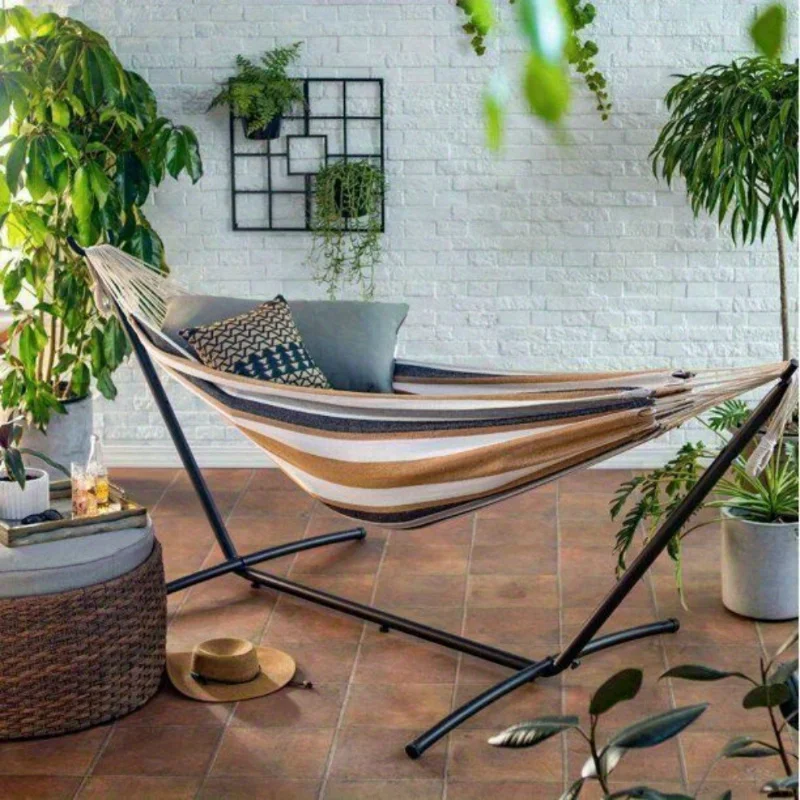
Proper indoor outdoor hammock placement principles apply equally to ultralight models. When hung correctly with appropriate sag and used with a diagonal lying position, these hammocks create an ergonomically superior sleep surface that many users find helps alleviate back pain by providing excellent spinal alignment without pressure points.
Research on sleep positions suggests that the gentle cradling effect of a properly hung hammock can actually improve sleep quality for many users compared to flat ground sleeping. The slightly elevated head position (around 10-30 degrees) may reduce instances of sleep apnea and improve circulation—benefits preserved in ultralight models.
User surveys consistently show that experienced hammock campers report better sleep quality compared to tent camping, with many citing the gentle rocking motion and ideal body positioning as key factors that remain present even in the lightest hammock designs.
Quick Setup & Portability: The Trail Efficiency Factor
One of the least appreciated advantages of ultralight hammocks is their remarkable setup efficiency. While weight savings get the spotlight, the time and effort saved during camp setup and takedown can significantly enhance your overall outdoor experience.
Most experienced users can set up an ultralight hammock system in 2-5 minutes—substantially faster than the average tent setup time of 5-15 minutes. This efficiency becomes particularly valuable in adverse conditions like rain, where minimizing setup time means less exposure to the elements.
The setup process is inherently simpler:
1. Identify suitable trees
2. Wrap tree straps around each trunk
3. Attach hammock to suspension system
4. Make minor adjustments for ideal tension
The packability of lightweight hammocks creates additional efficiency benefits throughout your trip. The minimal packed volume means easy access in your backpack and less time spent compressing and organizing gear. Many ultralight hammocks can be stuffed rather than carefully folded, further reducing camp breakdown time.
Site selection flexibility represents another significant advantage. While tent campers require flat, clear ground (increasingly difficult to find in popular camping areas), hammock users need only identify two appropriately spaced trees. This often means less time spent searching for suitable campsites and the ability to set up in locations that would be impossible for ground sleepers.
This combination of fast setup, simple process, and flexible site requirements can add hours of usable time to a multi-day trip—time better spent hiking, exploring, or simply relaxing.
Ultralight Suspension Systems: The Complete Guide
The suspension system connects your hammock to anchor points (typically trees) and represents a critical component of any ultralight setup. While the hammock body itself might get more attention, suspension systems offer significant opportunities for weight reduction without sacrificing safety or functionality.
Camping hammock sets with bug nets often include integrated suspension systems, but understanding the options helps you optimize your complete setup:
Webbing Straps: Flat, wide (0.75-1.5 inch/1.9-3.8 cm) polyester or nylon straps that wrap around trees. These distribute pressure to prevent bark damage and typically weigh 2-4 ounces (57-113g) per pair. Tree-friendly versions are essential for Leave No Trace practices.
Whoopie Slings: Adjustable suspension made from Amsteel or similar high-strength cord using a constricting loop design. These weigh just 0.5-1 ounce (14-28g) per pair and offer precise length adjustment but require separate tree straps.
Buckle Systems: Hardware-based adjusters that allow for quick length changes. These add 1-2 ounces (28-57g) over more minimal options but provide the easiest adjustment for beginners.
Toggles and Marlin Spike Hitches: Ultralight minimalist options using a simple stick or toggle through a loop. These can weigh under 0.5 ounces (14g) but require some knot knowledge.
For true ultralight setups, a combination of tree straps (for tree protection) with whoopie slings or a marlin spike hitch provides the optimal balance of weight, adjustability, and environmental responsibility. The weight difference between the heaviest and lightest suspension options can exceed 4 ounces (113g)—significant in the ultralight world.
Always select trees at least 6 inches (15 cm) in diameter, healthy, and living to ensure both your safety and minimal environmental impact. Proper spacing (typically 12-15 feet/3.7-4.6 meters) creates the ideal hang angle of approximately 30 degrees from horizontal.
Essential Accessories: Completing Your Ultralight Sleep System
While the hammock itself forms the foundation of your sleep system, accessories transform it into a true three-season or four-season shelter. The key is selecting minimalist accessories that maintain the ultralight philosophy while providing necessary functionality.
Insulation Options:
Hammocks lose heat primarily through compression and convection underneath your body, making underquilts essential for temperatures below 70°F (21°C):
- Down Underquilts: Offering the best warmth-to-weight ratio (typically 10-22 oz/283-624g), these provide exceptional insulation but require careful moisture management
- Synthetic Underquilts: Slightly heavier (12-25 oz/340-709g) but maintain insulation when damp, making them more forgiving in humid conditions
- Ultralight Sleeping Pads: The lightest option (8-14 oz/227-397g) but less comfortable and prone to shifting during sleep
Weather Protection:
Tarps provide essential protection from rain, wind, and sun:
- Asymmetrical Tarps: Minimalist design (6-10 oz/170-283g) matching the diagonal lay of the hammock
- Diamond/Hex Tarps: Versatile shape (8-12 oz/227-340g) offering good coverage with minimal weight
- Winter Tarps: Full-coverage designs (12-16 oz/340-454g) with doors for complete protection
Bug Protection:
Essential in many environments:
- Integrated Bug Nets: Attached to the hammock (2-5 oz/57-142g additional weight)
- Separate Bug Nets: Envelope the entire hammock (4-8 oz/113-227g) but offer complete protection
- Bottom-Entry Nets: Ultralight option (2-4 oz/57-113g) that seals around the hammock
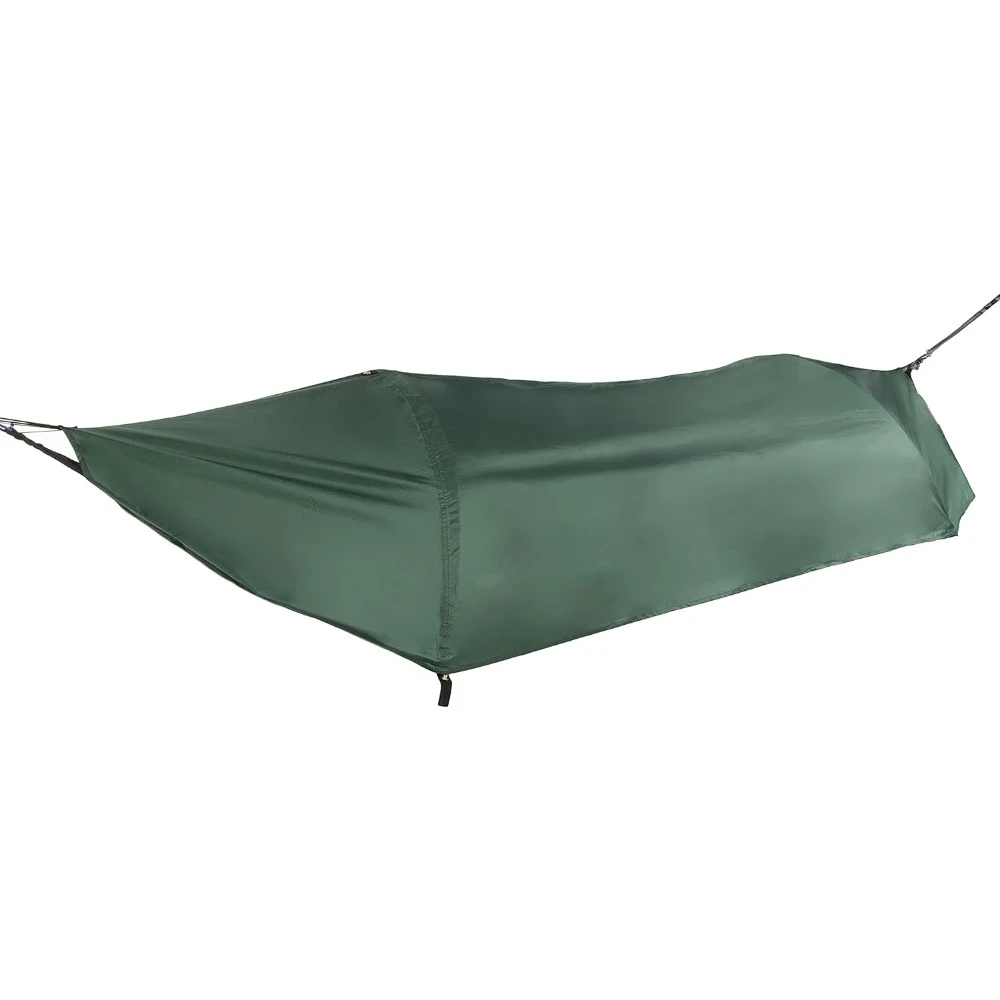
A complete camping hammock system for three-season use typically weighs 25-40 ounces (709-1,134g)—still significantly lighter than equivalent tent setups while often providing superior comfort. The key to maintaining ultralight status while adding accessories is selecting components specifically designed for weight efficiency rather than adapting standard equipment.
Camping Hammock Sets with Bug Net, Ultralight Camping Hammock Sets
$139.72 Select options This product has multiple variants. The options may be chosen on the product pageCamping Hammock Sets with Bug Net, Complete Camping Hammock Systems
Price range: $82.73 through $97.96 Select options This product has multiple variants. The options may be chosen on the product pageFolding Hammock Sets, Lightweight Hammock Sets
$295.80 Select options This product has multiple variants. The options may be chosen on the product pageComplete Camping Hammock Systems, Hanging Egg Chair Sets
$266.73 Select options This product has multiple variants. The options may be chosen on the product pageComplete Camping Hammock Systems, Folding Hammock Sets, Lightweight Hammock Sets, Quick Setup Hammock Sets
$255.54 Select options This product has multiple variants. The options may be chosen on the product page
When selecting accessories, prioritize those that serve multiple functions—for example, a properly sized tarp can provide both rain protection and wind blocking, potentially reducing the need for additional insulation in milder conditions.
Weather Performance: Protection in the Elements
Ultralight hammock systems demonstrate remarkable adaptability to various weather conditions when properly configured and used. With the right accessories and setup techniques, these minimalist shelters can keep you comfortable and dry in surprisingly challenging environments.
Rain protection relies primarily on proper tarp deployment. The optimal setup creates sufficient overhang (typically 8-12 inches/20-30 cm) beyond the hammock ends while maintaining appropriate height (usually 8-12 inches/20-30 cm above the hammock) to prevent splash-back. Ridgeline-hung tarps provide the most consistent coverage, maintaining their position regardless of hammock movement.
Wind management requires strategic positioning. Hanging your hammock system with the foot end facing the prevailing wind reduces cold air penetration, while setting your tarp lower on the windward side creates an effective barrier. Some advanced users employ a technique called “doors” by folding tarp corners inward to create near-complete enclosure in severe conditions.
Temperature control involves layering your insulation appropriately. While proper hammock installation safety remains consistent across seasons, your insulation strategy must adapt:
- Summer (60°F+/15°C+): Minimal underquilt or sleeping pad
- Three-Season (30-60°F/-1 to 15°C): Full-length underquilt with appropriate temperature rating
- Winter (Below 30°F/-1°C): Full-length, higher-rated underquilt plus top insulation and possibly a winter tarp with doors
The most challenging condition for hammock camping is typically cold, windy rain—requiring careful integration of all your weather protection systems. However, experienced hammock campers regularly report staying drier in properly configured hammock systems than in tents during extended rainy periods, largely because they remain elevated above pooling water.
Durability Factors: Will Your Ultralight Hammock Last?
The durability question represents a legitimate concern for ultralight gear. While lower denier fabrics inherently offer less abrasion resistance than heavier materials, proper care and usage techniques can significantly extend the lifespan of ultralight hammocks.
Material longevity varies significantly by denier rating and construction quality. Under normal use conditions:
- 1.0-1.2 oz (per yard) fabrics (approximately 20D): 300-500 nights with careful use
- 1.6-1.7 oz fabrics (approximately 40D): 500-1,000 nights with standard care
- 2.2+ oz fabrics (70D+): 1,000+ nights with basic maintenance
Usage patterns dramatically impact these estimates. Weekend warriors using their hammock 20 nights per year might see a decade or more of service from ultralight equipment, while thru-hikers covering thousands of miles in a single season operate under different durability requirements.
Essential care practices include:
- Cleaning: Hand wash only with gentle soap, never machine wash or dry
- Storage: Always store loose (never compressed) in a cool, dry place
- Sun Exposure: Minimize UV exposure, which degrades even the strongest synthetic fibers
- Sharp Objects: Keep away from abrasive surfaces and pointed objects
- Entry/Exit Technique: Use a “sit-and-slide” method rather than jumping in
Regular inspection helps identify potential issues before they become critical. Pay special attention to stitching at attachment points, fabric near metal hardware, and areas exposed to repeated friction. Small repairs made promptly (using ripstop repair tape or simple stitching) can prevent catastrophic failures later.
How to Select the Right Ultralight Hammock: Decision Framework
Choosing the ideal ultralight hammock requires balancing personal needs, usage patterns, environment, and budget. This decision framework helps navigate the options methodically rather than being overwhelmed by technical specifications.
Start by honestly assessing your primary usage scenario:
* Ultralight Backpacking: Prioritize minimum weight and packed size above all else
* Weekend Trips: Balance moderate weight savings with added comfort features
* Casual/Car Camping: Consider durability and convenience features over absolute weight minimization
* Thru-Hiking: Focus on durability-to-weight ratio for extreme long-term use
Your typical environment dictates essential features:
* Warm, Dry Climates: Minimal accessories, possibly no bug protection
* Humid, Buggy Regions: Integrated bug protection becomes essential
* Rainy Areas: Focus on quality tarp compatibility and weather protection
* Alpine/Variable: Consider versatile accessories for rapid weather changes
Physical characteristics matter significantly:
* Height: Users over 6’ (183 cm) need longer hammocks (minimum 10’/3m)
* Weight: Heavier users should prioritize higher capacity ratings
* Sleeping Style: Side-sleepers benefit from wider, asymmetrical designs
* Comfort Sensitivity: Some users willingly accept more weight for comfort features
While budget considerations are real, camping hammocks with stands and accessories represent a significant investment. Consider long-term value rather than just initial cost—a quality ultralight system might cost more upfront but provide better performance and longevity than budget alternatives.
Key specifications to compare include:
* Weight (hammock body only)
* Packed dimensions
* Dimensional measurements (length × width)
* Weight capacity
* Fabric denier and material
* Included features (ridgeline, bug net, etc.)
* Warranty terms
Ultralight vs. Standard Hammocks: Is the Weight Savings Worth It?
The decision to invest in ultralight equipment always involves trade-offs. Understanding the exact nature of these compromises helps determine if ultralight hammocks are right for your specific needs.
Weight savings represent the most obvious benefit—typically 8-12 ounces (227-340g) reduction compared to standard hammocks. While this might seem minimal in isolation, when combined with other ultralight gear choices, the cumulative effect can reduce pack weight by 5-10 pounds (2.3-4.5 kg) or more.
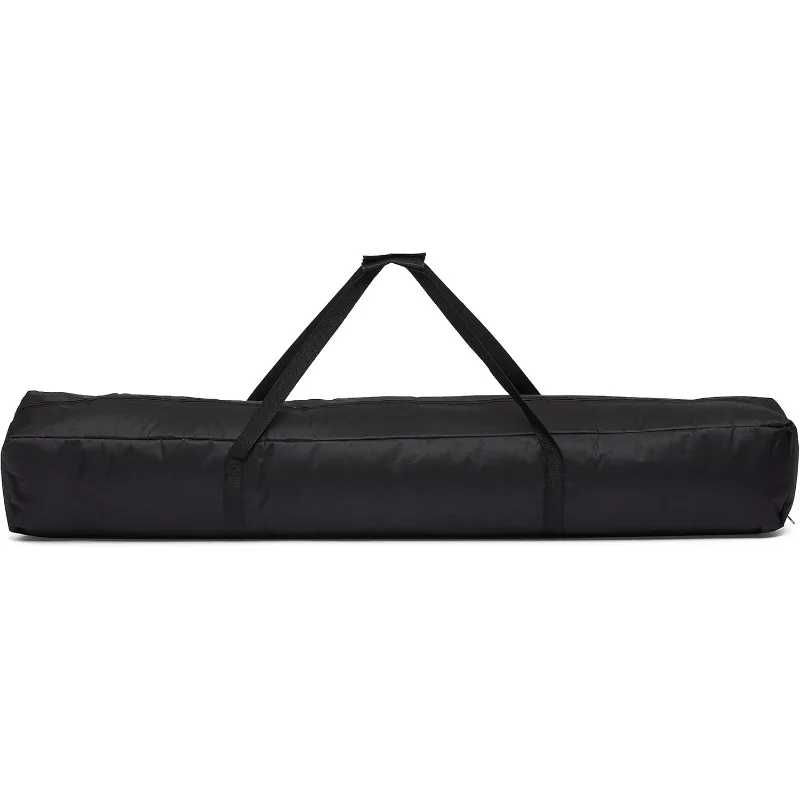
This weight reduction comes at a price premium—typically 30-50% higher than comparable standard hammocks. A quality ultralight hammock might cost $70-150, while standard versions range $40-100. Complete ultralight systems (including suspension, insulation, and weather protection) can reach $300-500 compared to $200-350 for standard systems.
Scenarios where ultralight hammocks deliver the greatest value include:
* Long-distance backpacking where every ounce matters
* Trips involving significant elevation gain where weight impacts exertion
* Users with physical limitations who benefit from reduced carry weight
* Activities where pack space is extremely limited
Conversely, scenarios where standard hammocks may make more sense include:
* Primarily car camping with minimal hiking
* Users very near weight capacity limits
* Extremely rough usage conditions
* Significant budget constraints
The durability equation factors heavily into this value assessment. While a standard hammock might last slightly longer under identical conditions, the difference is often less significant than perceived. A quality ultralight hammock used with proper care might need replacement after 500 nights, while a standard version might last 700—a difference that takes many years to manifest for typical users.
Advanced Hanging Techniques: Mastering Your Ultralight Setup
Mastering proper hanging techniques transforms the ultralight hammock experience from merely acceptable to truly exceptional. These advanced approaches maximize comfort while minimizing stress on lightweight materials.
The foundation of proper hanging begins with the 30° suspension angle—the optimal balance between flat sleeping position and structural efficiency. This angle creates the appropriate amount of sag while minimizing lateral forces on trees and suspension components. Visual assessment: when properly hung, your suspension straps should form an angle approximately matching your extended thumb and index finger.
Perfect diagonal positioning requires experimentation based on your body proportions. Most users find optimal comfort at approximately 30-45° off-center, creating a remarkably flat sleeping surface. This position works with human anatomy by allowing shoulders and feet to find natural alignment while cradling the torso and legs.
Ridgeline adjustment offers personalized comfort fine-tuning. The standard recommendation of 83% of hammock length (e.g., 100-inch/254 cm ridgeline for a 120-inch/305 cm hammock) provides a good starting point, but adjusting this length by 1-2 inches (2.5-5 cm) in either direction can dramatically change the feel. Shorter ridgelines create deeper sags, while longer ones produce flatter but tighter surfaces.
While indoor hammock safety follows different principles, outdoor site selection becomes critical for ultralight systems. Look for:
- Healthy, living trees 6-12 inches (15-30 cm) in diameter
- Spacing appropriate for your hammock length plus suspension (typically 12-15 feet/3.7-4.6 meters)
- Protection from prevailing winds when possible
- Absence of deadfall hazards or widow-makers above
- Minimal impact location following Leave No Trace principles
Common comfort issues can be addressed through simple adjustments:
* Shoulder squeeze: Try a wider hammock or more extreme diagonal position
* Calf pressure: Place a small pillow or clothing bundle under your knees
* Lower back strain: Ensure sufficient sag in your hang (not too tight)
* Cold spots: Adjust underquilt position to eliminate air gaps
FAQ: Common Questions About Ultralight Hammocks
Are ultralight hammocks safe for everyday use?
Yes, when used within their stated weight capacity and properly hung. Quality ultralight hammocks undergo rigorous testing and include significant safety margins. However, they do require more careful handling than heavier versions to prevent damage from sharp objects or abrasion.
Can two people sleep in an ultralight hammock?
Generally no. While “double” ultralight hammocks exist, they’re primarily designed to give single users more comfort rather than accommodate two adults for sleeping. Brief sitting together is possible within weight limits, but overnight sleeping for two is impractical and uncomfortable in any hammock not specifically designed as a two-person system.
What’s the minimum tree diameter needed for safe hanging?
For ultralight systems, trees should be at least 6 inches (15 cm) in diameter to distribute load safely and prevent damage to the tree. Larger trees (8-12 inches/20-30 cm) are preferable for maximum stability and environmental protection.
How do I prevent shoulder squeeze in narrow hammocks?
The diagonal lay is crucial—position your body at approximately 30-45 degrees from the centerline. Additionally, ensure sufficient sag (not too tight) and consider a slightly wider hammock if you have broader shoulders. Some users find asymmetrical designs particularly helpful for eliminating this common issue.
Can I use a sleeping pad instead of an underquilt?
Yes, but with compromises. Sleeping pads provide adequate insulation but tend to shift during the night and create pressure points that underquilts avoid. If using a pad, closed-cell foam often works better than inflatable types, and pad-specific hammocks with dual layers or sleeves can help keep it in position.
How durable are ultralight hammocks for long-term use?
With proper care, quality ultralight hammocks typically last 300-500 nights of use. Key longevity factors include protection from UV exposure, avoiding sharp objects, proper cleaning, and appropriate storage (never stored compressed or damp).
Do I need specialized trees for hanging ultralight hammocks?
Not specialized trees, but appropriate ones. Look for healthy, living trees without signs of disease or damage. Avoid dead trees, those with loose bark, or species with particularly soft wood. The distance between trees should accommodate your hammock length plus suspension (typically 12-15 feet/3.7-4.6 meters).
Can ultralight hammocks handle storm conditions?
Yes, when properly set up with appropriate accessories. A quality tarp deployed in storm mode (lower to the hammock with closed ends), combined with proper site selection (protected from prevailing winds), can handle surprisingly severe weather. Many experienced hammock campers report staying drier in storms than tent users.


